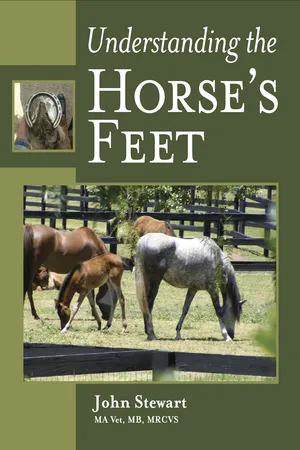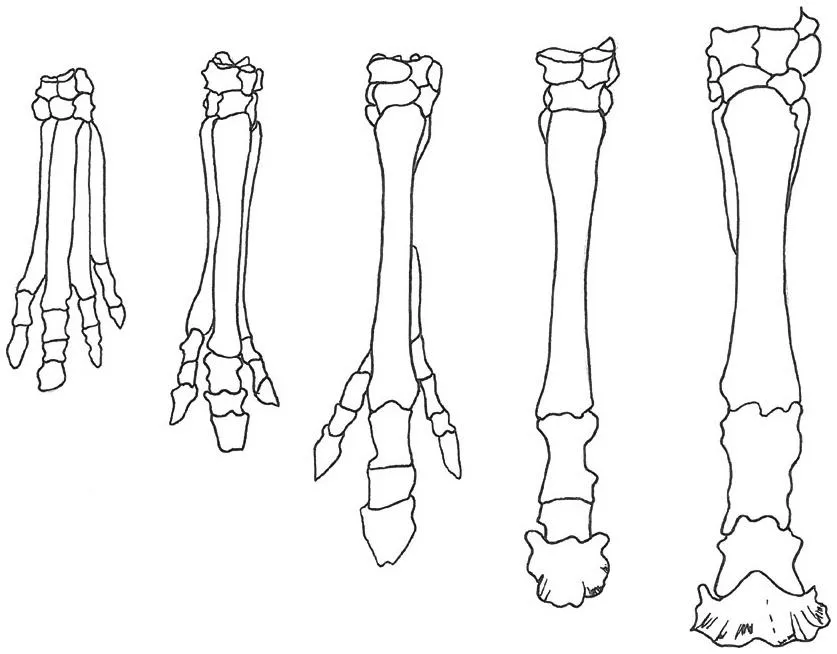1 Evolution
If you place your hand on a table and, while leaving the finger tips in contact, raise it up until it is vertical, you will be left with just one fingernail touching the table. This illustrates the adaptive process in the horse’s foot which has taken place over millions of years, starting with the horse’s ancestors, Eohippus, up to the horses and ponies known collectively as Equus, which are around today.
Ancestors of the horse existed fifty million years ago, but were very different to the creature that we recognize now. Eohippus was a small hare-like animal, living and running around in swampy undergrowth on feet with four long splayed toes. As the climate changed and became drier, the swamps and forests gradually disappeared and were replaced by open plains, and Eohippus had to adapt to take advantage of this new environment in order to survive. Modifications in its tooth structure enabled it to cope with grazing pasture rather than browsing bushes, and by changing its limb structure it was better able to survive in the open ground.
The limb changes included increasing the length of the legs, which allowed these prehistoric horses to take longer strides and so enabled them to run faster to escape from predators. Part of this leg-lengthening process was achieved by raising the digits to a more upright position. In the exercise described in the first paragraph, when you raised your hand from the table, the first finger to lose contact was your thumb; this digit was in fact already absent in the Eohippus, which had only four toes – but when you raised the hand further, the little finger lost contact, and this demonstrates the adaption that occurred over twenty million years, and can be seen in the Mesohippus, which had only three toes.
In the next twenty million years the digits became even more upright, with the inside and outside toes reducing in size so that they probably only made contact in wetter ground: the horse that characterized this evolutionary stage was called the Merychippus. The Pliohippus, which lived between ten and one million years ago, had one long toe, and Equus, the modern horse, adapted further to end up moving around on its middle finger nail, the hoof. The remnants of the other two digits were retained as the splint bones, lying just to the back of the cannon bone (the third metacarpus) and acting as support to the horse’s knee (the equivalent of our wrist).
The anatomy of the equine digit is somewhat different from our equivalent finger, although the basic form is similar. If, with a straight arm, you press down on your middle finger till your finger is bent back by about forty-five degrees to the perpendicular, this is the equivalent position of the horse’s lower limb.
ADAPTATIONS NECESSARY FOR EOHIPPUS’ SURVIVAL
So what were the adaptations required in Eohippus in order for him and his descendants to survive the change from forest to prairie? Already mentioned is the reduction in the number of digits, with more toes being of benefit in marshy ground, but a single one being better for firmer ground. However, in order to survive, these prehistoric horses also needed stamina to endure the long migrations required to find food and water, and the ability to remain standing a lot of the time in an energy-efficient way.
The Requirement for Speed
The speed of movement of an animal depends on the length and frequency of its stride: the longer and quicker the stride, the faster the animal will go. As well as lengthening the lower bones of the limbs and adopting a more upright posture, an increase in stride length in the horse was achieved by an evolutionary change which resulted in the loss of the clavicle (collar bone), thereby allowing a greater range of movement of the shoulder.
An increase in stride frequency was achieved as a result of a number of evolutionary changes, which included the reduction in weight of the lower limb by reducing the number of digits (as explained above). As the lower bones of the legs became longer, the upper bones of the limb remained short, and the heavy muscles that attach the trunk to these bones became more powerful. Reciprocal pulley systems evolved, with the arrangement of the tendons allowing the limb joints to bend or straighten together – wind resistance is reduced by the horse being able to fold the legs up under the body when he is moving at speed.
The Requirement for Stamina
The stamina required for long migrations was improved by evolving with ‘energy-efficient motion’. The tendons and ligament that support the fetlock joint – the ‘suspensory apparatus’ – evolved to be better able to store energy, to act like a spring, and as the leg bones became longer, so too did the tendons, to produce larger ‘springs’. This reduces the energy required by the muscles when the horse moves, allowing it to travel further with less effort.
The Requirement to Save Energy while Standing
As the horse evolved to be a plains-living animal, it increasingly relied on flight to escape from predators, and it was therefore important that it stayed on its feet to enable a quick getaway. It developed mechanisms to enable it to rest whilst standing: these are referred to as its ‘stay apparatus’. This describes the system of ligaments in the horse’s legs, which help to support it when it is standing, so that it can maintain the limb joints extended with minimal energy use. It can also ‘lock’ the patella (the knee-cap) in the hind legs, and has supporting ligaments to the superficial and deep digital flexor tendons – the superior and inferior ‘check’ ligaments – which allow the muscles to relax while tension is maintained in the tendons, thus conserving energy.
EQUUS
Along with our domesticated horses, ponies and donkeys, the species Equus includes the zebra, wild asses, and the only species of wild horse surviving, the Mongolian wild horse, or Przewalski’s horse, named after the Russian explorer who discovered it. These horses would be extinct in the wild were it not for breeding programmes in zoos which have allowed their reintroduction to Central Asia, and the re-establishment of a viable population.
Man has only been involved in the selective breeding of horses within the past three and a half thousand years, since they were first domesticated, thereby producing the diverse range of breeds that we see today. Initially, domesticated horses were used for work and war, but whereas the donkey is still used in many countries as a ‘beast of burden’, the role of the horse has changed, and in most countries it is now mainly used for pleasure, and often in the pursuit of sports.
Selective breeding has produced stronger animals to cope with the ‘unnatural’ situation of carrying a rider, but by breeding for certain sporting requirements, some other, more detrimental, characteristics have been perpetuated. At the individual level, many are bred for sentimental reasons or financial gain, rather than concentrating on producing offspring of better structural quality. Unfortunately, man has also significantly altered the lifestyle for these domesticated horses, away from the environment in which they evolved to survive. Providing a diet that is often far removed from the foodstuffs and forage that would be available in the wild, and limiting the horse’s opportunity to satisfy its innate requirement for movement, has resulted in changed metabolic processes in its body, and in particular in its feet – which is the aspect of greater interest to us.
2 The Structure and Anatomy of the Foot
Although this book is about the horse’s feet, it is vitally important not to consider them in isolation because the feet affect the rest of the horse, and the rest of the horse affects what happens to the feet. Because a horse’s weight is distributed between its four limbs, and it is the four feet that have to carry it all, the greatest challenge to the foot is how to deal with the forces of impact and weight-bearing. The foot is generally able to withstand these forces because all the structures in it play their part in absorbing or spreading these forces – these include:
- Laminae (stretch)
- Hoof capsule (change of shape)
- Sole (stretching and flattening)
- Circulation (hydraulic response)
- Bone (minimal)
- Articular cartilage (compression)
- Ligaments (stretch)
- Tendons (stretch)
- Frog (compression)
- Digital cushion (compression)
- Collateral cartilages (load redistribution)
Although this chapter may appear challenging for readers as they are introduced to an unfamiliar vocabulary, some knowledge of the anatomy of the different structures in the horse’s foot will give an insight into how the foot copes with these forces, and I hope will help the reader better understand the chapters that follow.
THE PROPERTIES OF BONE
Bones must be strong enough to support the weight of the body; they must be big enough – have a large enough surface area – to support soft tissue attachments; and they must be light enough in weight to reduce inertia – to minimize the effort required for rapid movement of the legs.
STRUCTURAL PROTEINS IN THE BODY
Collagen is a protein made up of chains of amino...




